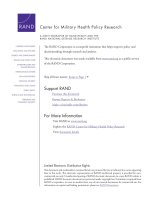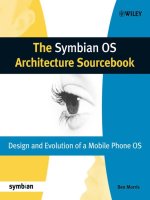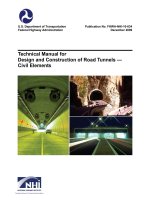DESIGN AND CONSTRUCTION OF BIOSENSING PLATFORMS FOR THE DETECTION OF BIOMARKERS
Bạn đang xem bản rút gọn của tài liệu. Xem và tải ngay bản đầy đủ của tài liệu tại đây (3.58 MB, 168 trang )
DESIGN AND CONSTRUCTION OF BIOSENSING
PLATFORMS FOR THE DETECTION OF
BIOMARKERS
DENG HUIMIN
(B. Sc., SICHUAN UNIVERSITY)
A THESIS SUBMITTED
FOR THE DEGREE OF DOCTOR OF
PHILOSOPHY
DEPARTMENT OF CHEMISTRY
NATIONAL UNIVERSITY OF SINGAPORE
2015
i
Declaration
I hereby declare that this thesis is my original work and it has been written
by me in its entirety, under the supervision of Assoc. Prof. Gao Zhiqiang, (in
the Biosensors and Electroanalytical Laboratory located at S5-02-03),
Chemistry Department, National University of Singapore, between August
2011 and April 2015. I have duly acknowledged all the sources of information
which have been used in the thesis. This thesis has also not been submitted for
any degree in any university previously.
The content of the thesis has been partially published in:
1. H. M. Deng, W. Shen, Z. Q. Gao, Chemphyschem. 2013, 14, 2343-
2347.
2. H. M. Deng, A. K. L. Teo, Z. Q. Gao, Sensor. Actuat. B-Chem. 2014,
191, 522-528.
3. H. M. Deng, X. J. Yang, S. P. X. Yeo, Z. Q. Gao, Anal. Chem. 2014,
86, 2117-2123.
4. H. M. Deng, X. J. Yang, Z. Q. Gao, Analyst 2015, 140, 3210-3215.
5. X. M. Guo, H. M. Deng, H. Zhou, T. X. Fan, Z. Q. Gao, Sensor.
Actuat. B-Chem. 2015, 206, 721-727.
Deng Huimin April, 2015
Name Signature Date
ii
Acknowledgements
First and foremost, I would like to thank my supervisor, Assoc. Prof. Gao
Zhiqiang, for his guidance, help, and timely advice during my PhD study. His
efficiency, immense knowledge, and critical thinking in scientific research
have inspired me a lot. I really appreciate his patience in guiding me on the
academic writing and revising my manuscripts.
I would also like to thank the research fellow in our laboratory, Dr. Yang
Xinjian, for his useful suggestions on the design of my experiments and the
discussion on the experimental results.
I would like to express my gratitude to the honors students Mr. Teo Kay
Liang Alan, Ms. Yeo Pei Xing Stephanie, and Ms. Png Si Ying for their
cooperation in the final year projects which have been included partially in my
thesis. I am also grateful to my other lab mates Ms. Shen Wei, Dr. Li Ying, Dr.
Shnamuga Sundaram Komathi, Ms. Ren Yuqian, Ms. Zhang Yanmei, Ms. Guo
Xingmei, Mr. Chen Chengbo, and Ms. Guo Yuwenxi for their help.
I really appreciate my family and friends for their support and
encouragements. I especially thank my parents, Mr. Deng Xianshun and Mdm.
Tan Meirong, for their endless love and being a pillar of strength during my
frustration period during my PhD study.
Financial support from National University of Singapore is gratefully
acknowledged.
iii
Table of Contents
Declaration i
Acknowledgements ii
Table of Contents iii
Summary vii
List of Tables x
List of Figures xi
List of Schemes xv
List of Abbreviations xvi
Chapter 1. Introduction 1
1.1 Biosensors 2
1.1.1 Definition of a biosensor 2
1.1.2 Applications of biosensors 3
1.1.3 Classification of biosensors 4
1.2 Glucose biosensors 7
1.2.1 Diabetes mellitus and glucose sensing 7
1.2.2 History of electrochemical glucose biosensors 9
1.2.2.1 First generation of glucose biosensors 10
1.2.2.2 Second generation of glucose biosensors 11
1.2.2.3 Third generation of glucose biosensors 12
1.2.3 Interference issue in electrochemical glucose biosensors 13
1.2.3.1 Permselective membrane covering 13
1.2.3.2 Operation potential lowering 14
1.3 DNA MTase activity biosensors 15
1.3.1 DNA methylation 15
1.3.2 DNA MTase biomarker in cancer 17
1.3.3 Methods for the detection of DNA MTase activity 19
1.3.3.1 Electrochemical DNA MTase biosensors 20
1.3.3.2 Optical DNA MTase activity biosensors 22
1.4 Objectives and significance of the studies 24
1.5 Scope and overview of the thesis 25
iv
Chapter 2. An interference-free glucose biosensor based on an anionic redox
polymer-mediated enzymatic oxidation of glucose 29
2.1 Introduction 29
2.2 Experimental 29
2.2.1 Materials and apparatus 29
2.2.2 Glucose Biosensor Fabrication 31
2.3. Results and discussion 31
2.3.1 Electrochemical Characteristics of the Biosensor 31
2.3.2 Optimization 34
2.3.3 Analytical Performance of the Biosensor 37
2.4. Conclusion 40
Chapter 3. An interference-free glucose biosensor based on a novel low potential
redox polymer mediator 41
3.1 Introduction 41
3.2 Experimental 42
3.2.1 Reagents and appratus 42
3.2.2. Preparation of the redox polymer 43
3.2.3. Preparation of the biosensor 43
3.3 Results and discussion 44
3.3.1. Synthesis and characterization of the Ru-RP 44
3.3.2. Electrochemical characteristics of the biosensor 46
3.3.3. Optimization of the biosensor 50
3.3.4. Analytical performance of the biosensor 52
3.4 Conclusion 58
Chapter 4. Detection of glucose with a lamellar-ridge architecture gold modified
electrode 60
4.1 Introduction 60
4.2 Experimental 62
4.2.1 Reagents and apparatus 62
4.2.2 Preparation of gold samples 63
4.2.3 Glucose sensor fabrication 64
4.2.4 Cyclic voltammetric and amperometric experiment 65
4.2.5 Finite element simulation 65
4.3 Results and discussion 65
4.3.1 Architecture and composition characterization 65
v
4.3.2 Electrochemical examination 67
4.3.3 Amperometric detection of glucose 69
4.3.4 Mass transport analysis 73
4.4 Conclusion 74
Chapter 5. A highly sensitive electrochemical methyltransferase activity biosensor . 76
5.1 Introduction 76
5.2 Experimental 76
5.2.1 Reagents and apparatus 76
5.2.2 M.SssI MTase catalyzed DNA methylation event confirmation by gel
electrophoresis 78
5.2.3 Double-stranded DNA and electrode preparation 79
5.2.4 MTase activity detection 80
5.2.5 Selectivity and inhibition investigation of the M.SssI MTase biosensor 80
5.3 Results and discussion 81
5.3.1 MTase activity biosensor principle 81
5.3.2 Electrochemical characterization of modified electrode and feasibility
study 84
5.3.3 M.SssI MTase activity determination 89
5.3.4 Selectivity of the M.SssI MTase activity biosensor 90
5.3.5 Influence of inhibitors on M.SssI MTase activity 91
5.4 Conclusion 93
Chapter 6. MoS
2
nanosheets as an effective fluorescence quencher for DNA
methyltransferase activity detection 94
6.1 Introduction 94
6.2 Experimental 95
6.2.1 Materials and apparatus 95
6.2.2 Preparation of MoS
2
nanosheets 96
6.2.3 Feasibility study 97
6.2.4 Dam methyltransferase activity detection 98
6.2.5 Selectivity and inhibition study 98
6.3 Results and discussion 99
6.3.1 Characterization of MoS
2
nanosheets 99
6.3.2 Principle and feasibility of the Dam MTase activity biosensor 101
6.3.3 Dam methyltransferase activity detection 104
6.3.4 Selectivity and inhibition study 109
vi
6.4 Conclusion 111
Chapter 7. DAN methyltransferase activity detection using a personal glucose meter
112
7.1 Introduction 112
7.2 Experimental 114
7.2.1 Reagents and apparatus 114
7.2.2 Preparation and characterization of DNA-invertase conjugates 115
7.2.3 Hybridization of oligo 2 and oligo 1-invertase conjugates 116
7.2.4 Immobilization of ds-DNA-invertase onto magnetic beads 116
7.2.5 Optimization 117
7.2.6 Detection of M.SssI MTase activity using the PGM 117
7.2.7 Selectivity study 118
7.3 Results and discussion 118
7.3.1 Principle and feasibility of the portable M.SssI MTase activity biosensor
118
7.3.2 Optimization 121
7.3.3 Calibration study 123
7.3.4 Selectivity study of the proposed M.SssI MTase activity biosensor 124
7.4 Conclusion 125
Chapter 8. Conclusion and future outlook 126
8.1 Conclusion 126
8.1.1 Glucose biosensors 126
8.1.2 DNA MTase activity biosensors 128
8.2 Future outlook 130
References 132
vii
Summary
Biosensors can provide cost-effective, easy-to-use, sensitive and highly
accurate detection devices in a variety of research and commercial
applications. This thesis focuses on the development of novel biosensing
platforms for glucose and deoxyribonucleic acid (DNA) methyltransferase
(MTase) activity detection.
Firstly, two different types of mediators are employed to construct highly
sensitive and selective electrochemical glucose biosensors with excellent anti-
interference characteristics. One is an osmium-bipyridine complex (Os(bpy)
2
)
-based anionic redox polymer (Os-RP), and the other is a novel ruthenium
complex-tethered redox polymer (Ru-RP). The biosensing membranes are
formed through the co-immobilization of glucose oxidase (GOx) and the
mediators on the surfaces of glassy carbon electrodes (GCE) in a simple one-
step chemical crosslinking process. Both the fabricated Os-RP/GOx and the
Ru-RP/GOx biosensors show excellent electrocatalytic activity toward the
oxidation of glucose and exhibit good linear correlations between the
oxidation current and the glucose concentration up to 10 mM with a sensitivity
of 16.5 and 24.3 A mM
-1
cm
-2
, respectively. Moreover, both glucose
biosensors display outstanding anti-interference capabilities resulting from the
presence of anionic sulfonic acid groups in the backbones of the Os-RP and
the ultralow working potential (-0.15 V) of the Ru-RP, respectively. In
addition, a novel lamellar-ridge architectured gold (lamellar ridge-Au)
material is prepared using blue scales of Morph butterfly as templates.









